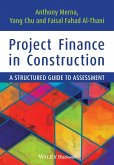- Broschiertes Buch
- Merkliste
- Auf die Merkliste
- Bewerten Bewerten
- Teilen
- Produkt teilen
- Produkterinnerung
- Produkterinnerung
This book draws together the main elements of strategic management theory and relates them to contemporary construction. It will help students understand what strategic management involves and how it is possible to develop a proactive approach to managing of key resources such as people and technology. The author argues that construction (production), is the logical conclusion of a decision-making process which has resulted in a requirement (need). Other books on strategic management tend to present strategy as being simply a matter of pursuing standard formulae that presents an organisation…mehr
Andere Kunden interessierten sich auch für
![Civil Engineer's Handbook of Professional Practice Civil Engineer's Handbook of Professional Practice]() Karen Lee HansenCivil Engineer's Handbook of Professional Practice170,99 €
Karen Lee HansenCivil Engineer's Handbook of Professional Practice170,99 €![Strategic Issues in Public-Private Partnerships Strategic Issues in Public-Private Partnerships]() Geert DewulfStrategic Issues in Public-Private Partnerships126,99 €
Geert DewulfStrategic Issues in Public-Private Partnerships126,99 €![An Effective Strategy for Safe Design in Engineering and Construction An Effective Strategy for Safe Design in Engineering and Construction]() David EnglandAn Effective Strategy for Safe Design in Engineering and Construction112,99 €
David EnglandAn Effective Strategy for Safe Design in Engineering and Construction112,99 €![Mobile and Pervasive Computing in Construction Mobile and Pervasive Computing in Construction]() Mobile and Pervasive Computing in Construction166,99 €
Mobile and Pervasive Computing in Construction166,99 €![Managing Construction Logistics Managing Construction Logistics]() Gary SullivanManaging Construction Logistics90,99 €
Gary SullivanManaging Construction Logistics90,99 €![Construction Management Construction Management]() Denny McGeorgeConstruction Management75,99 €
Denny McGeorgeConstruction Management75,99 €![Project Finance in Construction Project Finance in Construction]() Tony MernaProject Finance in Construction98,99 €
Tony MernaProject Finance in Construction98,99 €-
-
-
This book draws together the main elements of strategic management theory and relates them to contemporary construction. It will help students understand what strategic management involves and how it is possible to develop a proactive approach to managing of key resources such as people and technology. The author argues that construction (production), is the logical conclusion of a decision-making process which has resulted in a requirement (need). Other books on strategic management tend to present strategy as being simply a matter of pursuing standard formulae that presents an organisation with the most logical answer - known as prescriptive (planned) theory. However, organisations in contemporary business are increasingly aware that such deterministic methods are at risk from rapid fluctuations in a number of determinants, from private investment to government priorities. A more fluid approach to strategy is needed - known as 'the emergent approach'. This approach requires the organisation to create a structure and culture that enables it to be both nimble and adaptive in its response to change. The book draws useful lessons from other sectors and emphasises the particular nature of construction, especially the factors that have created the present state of the industry. The context in which the industry has traditionally operated - the contracting system - caused many of its current problems and also militated against implementing the sort of strategic change witnessed in other sectors. Through analysis of case studies, the book shows how vital lessons can be learned from elsewhere by benchmarking practices and developing alternative ways of delivering value to clients. A key message will be construction organisations can, using such knowledge, raise their ability to innovate and create sustainable competitive advantage.
Hinweis: Dieser Artikel kann nur an eine deutsche Lieferadresse ausgeliefert werden.
Hinweis: Dieser Artikel kann nur an eine deutsche Lieferadresse ausgeliefert werden.
Produktdetails
- Produktdetails
- Verlag: John Wiley & Sons / Wiley
- Seitenzahl: 336
- Erscheinungstermin: 29. März 2010
- Englisch
- Abmessung: 241mm x 170mm x 18mm
- Gewicht: 576g
- ISBN-13: 9781405159128
- ISBN-10: 140515912X
- Artikelnr.: 28776814
- Herstellerkennzeichnung
- Libri GmbH
- Europaallee 1
- 36244 Bad Hersfeld
- gpsr@libri.de
- Verlag: John Wiley & Sons / Wiley
- Seitenzahl: 336
- Erscheinungstermin: 29. März 2010
- Englisch
- Abmessung: 241mm x 170mm x 18mm
- Gewicht: 576g
- ISBN-13: 9781405159128
- ISBN-10: 140515912X
- Artikelnr.: 28776814
- Herstellerkennzeichnung
- Libri GmbH
- Europaallee 1
- 36244 Bad Hersfeld
- gpsr@libri.de
Steven McCabe, Senior Lecturer in construction management, University of Central England
Foreword
Preface
About the Author
Acknowledgements
Dedication
Chapter 1 Introduction
1.1 Trying to predict the future - a task fraught with risk
1.2 A journey towards strategy: art or science?
1.3 Strategy, a problem of expectation?
1.4 The dilemmas of a formal definition of strategy
1.5 The context of construction - a truly unique industry?
1.6 Developing an understanding of who 'consumes' construction
1.7 The structure of this book
Chapter 2 Strategic management theory: its origins, development and
relevance to contemporary organisations
2.1 Objectives of this chapter
2.2 Early origins
2.3 The rise and rise of strategy as a corporate tool
2.4 So what are the main concepts of strategy - back to the problems of
definition?
2.5 Mintzberg's 'Five Ps' conceptualisation of strategy
2.6 The hierarchy of strategy
2.7 Terms associated with strategy
2.8 Attaining success: the importance of analysis, development and
implementation
2.9 The three essentials of strategic decision-making
2.10 Lynch's text of 'good' strategy
2.11 What will really work? An exploration of major theoretical
perspectives
2.12 The relevance of strategic theory and some considerations of
Whittington's generic perspective
2.13 Conclusion
Chapter 3 A short socio-historical analysis of the development of the
British construction industry
3.1 Objectives of this chapter
3.2 Early origins - the beginnings of civilisation
3.3 The Roman influence
3.4 Medieval organisation - the emergence of the guild system
3.5 The malign influence of merchants
3.6 The end of artisans and the emergence of alternative arrangements
3.7 Contracting and its long-term effects on people, processes and
production
3.8 The rise and fall of trade unionism in construction
3.9 The National Building Strike and its long-term consequences
3.10 Time for change?
3.11 Government intervention - the impact of the 'Latham' and Rethinking
Construction reports
3.12 So where is construction currently and what is next?
3.13 Conclusion
Chapter 4 Understanding the environment - markets and competition
4.1 Objectives of this chapter
4.2 Appreciating the context of construction
4.3 How are markets considered?
4.4 Appreciating the dynamics of markets and competition
4.5 Overall analysis of the environment
4.6 What are the dynamics of competition? 71
4.7 Analysing competitive behaviour - a consideration of adaptive strategy
4.8 How do markets grow?
4.9 Competitive advantage
4.10 Conclusion
Chapter 5 Strategy and its connection with consumers and customers - the
keys to success
5.1 Objectives of this chapter
5.2 Defining consumers and customers
5.3 Customers - who are they and what do they want?
5.4 The use of 'customer-profiling'
5.5 Customer-competitor matrix
5.6 Importance-performance analysis
5.7 Market segmentation
5.8 Revisiting Miles and Snow's analytical model of competitive behaviour
5.9 Using the BCG matrix to analyse customers
5.10 The McKinsey Directional Policy Matrix
5.11 Considering the value of these matrices
5.12 Making connections with consumers - the importance of communication
and feedback
5.13 The emergence of the concept of customer as 'king' - what the Japanese
taught the west and how it has been developed
5.14 Conclusion
Chapter 6 Developing and maintaining organisational resources - the basis
for delivering strategy
6.1 Objectives of this chapter
6.2 Resource usage - an overview
6.3 A contemporary consideration of how organisations use resources
6.4 The objective of adding value to resources
6.5 How resources are valued - applying 'economic rent'
6.6 How organisations develop capability based on their resources -an
appreciation of the importance of the resource-based perspective (RBV)
6.7 Resources and their place in the structure
6.8 Using VRIO framework to decide on resource application
6.9 The importance of resources, distinctive capability and core
competences
6.10 Developing an understanding of people, productive capability and
finance
6.11 Using integration as a tactic to obtain resources
6.12 Conclusion
Chapter 7 'Organisation[al] matters' - a strategic perspective of the
importance of how to manage people
7.1 Objectives of this chapter - what is organisation?
7.2 Organisation and structure - a consideration of contemporary changes in
perception
7.3 Structure, processes and relationships - virtuous combinations?
7.4 Purpose and organisation
7.5 Setting objectives - the importance of mission
7.6 Organisational configuration
7.7 Leadership
7.8 Getting the best from people - the 'secret' of really successful
organisations
7.9 The importance of organisational culture
7.10 Conclusion
Chapter 8 Knowledge, innovation and technology - the 'keys' to the future
8.1 Objectives of this chapter
8.2 Knowing and doing - linking them together to ensure appropriate action
8.3 The context of construction
8.4 Defining knowledge
8.5 Learning as a way of organisational life
8.6 What is innovation?
8.7 The importance of technology
8.8 Conclusion
Chapter 9 Change - the only constant in strategy
9.1 Objectives of this chapter
9.2 The theoretical basis of change management
9.3 Strategic change in organisations - deriving an understanding of what
is involved
9.4 Types of strategic change
9.5 The causes of change
9.6 How to manage change
9.7 A change for the better? Challenging the assumptions of the planned
approach
9.8 Emergent models of change
9.9 The role of managers in change
9.10 Strategic leadership approaches
9.11 Changing the way things are really done
9.12 Communicating change
9.13 Potential problems with change
9.14 Conclusion
Chapter 10 Considering the development of strategic options
10.1 Objectives of this chapter
10.2 What to do?
10.3 The importance of resources in making choice
10.4 Using the value chain to consider resources
10.5 Andrews and SWOT
10.6 The use of a resource-based view
10.7 The importance of core competences
10.8 Using the six criteria to judge strategy
10.9 The ADL Matrix
10.10 Who makes the decision?
10.11 Using scenarios
10.12 The importance of context
10.13 Conclusion
Chapter 11 Implementing the strategy - issues, dilemmas and delivery of
strategic outcomes
11.1 Objectives of this chapter 223
11.2 Getting to the end - the difference between 'intended' and 'realised'
strategy
11.3 The influence of purpose and dynamics on resources used
11.4 Planning for action
11.5 Making it happen - the influence of Kaplan and Norton
11.6 Communication and approaches
11.7 Strategic control
11.8 Dealing with failure
11.9 How to recover
11.10 Retrenchment strategies
11.11 Turnaround strategies
11.12 Managing in recession and decline
11.13 What about turbulent markets?
11.14 A general review of how to ensure that strategy remains coherent
11.15 Conclusion
Chapter 12 Turning theory into practice - some empirical examples of
strategy in construction organisations
12.1 Introduction to this chapter
12.2 An overview of the contributions of strategic practice
12.3 Continual improvement in Thomas Vale as a way of life
12.4 Past, present and future - survival strategies in the face of a global
downturn in construction work
12.5 'Specialisation vs generalisation in the construction industry -a
strategic overview': Adonis construction
12.6 Interserve
12.7 Innovation and creativity in Morgan Ashurst
12.8 As safe as houses - the importance of the NHBC
12.9 Strategic management and change in construction: 'The Argent
Perspective'
12.10 Wates Construction
12.11 Strategic collaborative framework partnerships in Birmingham Urban
Design
12.12 Is it possible for a small quantity surveying consultancy to survive
and thrive in an economic crisis?
12.13 Strategic management in a micro-organisation
References
Further Reading
Glossary
Index
Preface
About the Author
Acknowledgements
Dedication
Chapter 1 Introduction
1.1 Trying to predict the future - a task fraught with risk
1.2 A journey towards strategy: art or science?
1.3 Strategy, a problem of expectation?
1.4 The dilemmas of a formal definition of strategy
1.5 The context of construction - a truly unique industry?
1.6 Developing an understanding of who 'consumes' construction
1.7 The structure of this book
Chapter 2 Strategic management theory: its origins, development and
relevance to contemporary organisations
2.1 Objectives of this chapter
2.2 Early origins
2.3 The rise and rise of strategy as a corporate tool
2.4 So what are the main concepts of strategy - back to the problems of
definition?
2.5 Mintzberg's 'Five Ps' conceptualisation of strategy
2.6 The hierarchy of strategy
2.7 Terms associated with strategy
2.8 Attaining success: the importance of analysis, development and
implementation
2.9 The three essentials of strategic decision-making
2.10 Lynch's text of 'good' strategy
2.11 What will really work? An exploration of major theoretical
perspectives
2.12 The relevance of strategic theory and some considerations of
Whittington's generic perspective
2.13 Conclusion
Chapter 3 A short socio-historical analysis of the development of the
British construction industry
3.1 Objectives of this chapter
3.2 Early origins - the beginnings of civilisation
3.3 The Roman influence
3.4 Medieval organisation - the emergence of the guild system
3.5 The malign influence of merchants
3.6 The end of artisans and the emergence of alternative arrangements
3.7 Contracting and its long-term effects on people, processes and
production
3.8 The rise and fall of trade unionism in construction
3.9 The National Building Strike and its long-term consequences
3.10 Time for change?
3.11 Government intervention - the impact of the 'Latham' and Rethinking
Construction reports
3.12 So where is construction currently and what is next?
3.13 Conclusion
Chapter 4 Understanding the environment - markets and competition
4.1 Objectives of this chapter
4.2 Appreciating the context of construction
4.3 How are markets considered?
4.4 Appreciating the dynamics of markets and competition
4.5 Overall analysis of the environment
4.6 What are the dynamics of competition? 71
4.7 Analysing competitive behaviour - a consideration of adaptive strategy
4.8 How do markets grow?
4.9 Competitive advantage
4.10 Conclusion
Chapter 5 Strategy and its connection with consumers and customers - the
keys to success
5.1 Objectives of this chapter
5.2 Defining consumers and customers
5.3 Customers - who are they and what do they want?
5.4 The use of 'customer-profiling'
5.5 Customer-competitor matrix
5.6 Importance-performance analysis
5.7 Market segmentation
5.8 Revisiting Miles and Snow's analytical model of competitive behaviour
5.9 Using the BCG matrix to analyse customers
5.10 The McKinsey Directional Policy Matrix
5.11 Considering the value of these matrices
5.12 Making connections with consumers - the importance of communication
and feedback
5.13 The emergence of the concept of customer as 'king' - what the Japanese
taught the west and how it has been developed
5.14 Conclusion
Chapter 6 Developing and maintaining organisational resources - the basis
for delivering strategy
6.1 Objectives of this chapter
6.2 Resource usage - an overview
6.3 A contemporary consideration of how organisations use resources
6.4 The objective of adding value to resources
6.5 How resources are valued - applying 'economic rent'
6.6 How organisations develop capability based on their resources -an
appreciation of the importance of the resource-based perspective (RBV)
6.7 Resources and their place in the structure
6.8 Using VRIO framework to decide on resource application
6.9 The importance of resources, distinctive capability and core
competences
6.10 Developing an understanding of people, productive capability and
finance
6.11 Using integration as a tactic to obtain resources
6.12 Conclusion
Chapter 7 'Organisation[al] matters' - a strategic perspective of the
importance of how to manage people
7.1 Objectives of this chapter - what is organisation?
7.2 Organisation and structure - a consideration of contemporary changes in
perception
7.3 Structure, processes and relationships - virtuous combinations?
7.4 Purpose and organisation
7.5 Setting objectives - the importance of mission
7.6 Organisational configuration
7.7 Leadership
7.8 Getting the best from people - the 'secret' of really successful
organisations
7.9 The importance of organisational culture
7.10 Conclusion
Chapter 8 Knowledge, innovation and technology - the 'keys' to the future
8.1 Objectives of this chapter
8.2 Knowing and doing - linking them together to ensure appropriate action
8.3 The context of construction
8.4 Defining knowledge
8.5 Learning as a way of organisational life
8.6 What is innovation?
8.7 The importance of technology
8.8 Conclusion
Chapter 9 Change - the only constant in strategy
9.1 Objectives of this chapter
9.2 The theoretical basis of change management
9.3 Strategic change in organisations - deriving an understanding of what
is involved
9.4 Types of strategic change
9.5 The causes of change
9.6 How to manage change
9.7 A change for the better? Challenging the assumptions of the planned
approach
9.8 Emergent models of change
9.9 The role of managers in change
9.10 Strategic leadership approaches
9.11 Changing the way things are really done
9.12 Communicating change
9.13 Potential problems with change
9.14 Conclusion
Chapter 10 Considering the development of strategic options
10.1 Objectives of this chapter
10.2 What to do?
10.3 The importance of resources in making choice
10.4 Using the value chain to consider resources
10.5 Andrews and SWOT
10.6 The use of a resource-based view
10.7 The importance of core competences
10.8 Using the six criteria to judge strategy
10.9 The ADL Matrix
10.10 Who makes the decision?
10.11 Using scenarios
10.12 The importance of context
10.13 Conclusion
Chapter 11 Implementing the strategy - issues, dilemmas and delivery of
strategic outcomes
11.1 Objectives of this chapter 223
11.2 Getting to the end - the difference between 'intended' and 'realised'
strategy
11.3 The influence of purpose and dynamics on resources used
11.4 Planning for action
11.5 Making it happen - the influence of Kaplan and Norton
11.6 Communication and approaches
11.7 Strategic control
11.8 Dealing with failure
11.9 How to recover
11.10 Retrenchment strategies
11.11 Turnaround strategies
11.12 Managing in recession and decline
11.13 What about turbulent markets?
11.14 A general review of how to ensure that strategy remains coherent
11.15 Conclusion
Chapter 12 Turning theory into practice - some empirical examples of
strategy in construction organisations
12.1 Introduction to this chapter
12.2 An overview of the contributions of strategic practice
12.3 Continual improvement in Thomas Vale as a way of life
12.4 Past, present and future - survival strategies in the face of a global
downturn in construction work
12.5 'Specialisation vs generalisation in the construction industry -a
strategic overview': Adonis construction
12.6 Interserve
12.7 Innovation and creativity in Morgan Ashurst
12.8 As safe as houses - the importance of the NHBC
12.9 Strategic management and change in construction: 'The Argent
Perspective'
12.10 Wates Construction
12.11 Strategic collaborative framework partnerships in Birmingham Urban
Design
12.12 Is it possible for a small quantity surveying consultancy to survive
and thrive in an economic crisis?
12.13 Strategic management in a micro-organisation
References
Further Reading
Glossary
Index
Foreword
Preface
About the Author
Acknowledgements
Dedication
Chapter 1 Introduction
1.1 Trying to predict the future - a task fraught with risk
1.2 A journey towards strategy: art or science?
1.3 Strategy, a problem of expectation?
1.4 The dilemmas of a formal definition of strategy
1.5 The context of construction - a truly unique industry?
1.6 Developing an understanding of who 'consumes' construction
1.7 The structure of this book
Chapter 2 Strategic management theory: its origins, development and
relevance to contemporary organisations
2.1 Objectives of this chapter
2.2 Early origins
2.3 The rise and rise of strategy as a corporate tool
2.4 So what are the main concepts of strategy - back to the problems of
definition?
2.5 Mintzberg's 'Five Ps' conceptualisation of strategy
2.6 The hierarchy of strategy
2.7 Terms associated with strategy
2.8 Attaining success: the importance of analysis, development and
implementation
2.9 The three essentials of strategic decision-making
2.10 Lynch's text of 'good' strategy
2.11 What will really work? An exploration of major theoretical
perspectives
2.12 The relevance of strategic theory and some considerations of
Whittington's generic perspective
2.13 Conclusion
Chapter 3 A short socio-historical analysis of the development of the
British construction industry
3.1 Objectives of this chapter
3.2 Early origins - the beginnings of civilisation
3.3 The Roman influence
3.4 Medieval organisation - the emergence of the guild system
3.5 The malign influence of merchants
3.6 The end of artisans and the emergence of alternative arrangements
3.7 Contracting and its long-term effects on people, processes and
production
3.8 The rise and fall of trade unionism in construction
3.9 The National Building Strike and its long-term consequences
3.10 Time for change?
3.11 Government intervention - the impact of the 'Latham' and Rethinking
Construction reports
3.12 So where is construction currently and what is next?
3.13 Conclusion
Chapter 4 Understanding the environment - markets and competition
4.1 Objectives of this chapter
4.2 Appreciating the context of construction
4.3 How are markets considered?
4.4 Appreciating the dynamics of markets and competition
4.5 Overall analysis of the environment
4.6 What are the dynamics of competition? 71
4.7 Analysing competitive behaviour - a consideration of adaptive strategy
4.8 How do markets grow?
4.9 Competitive advantage
4.10 Conclusion
Chapter 5 Strategy and its connection with consumers and customers - the
keys to success
5.1 Objectives of this chapter
5.2 Defining consumers and customers
5.3 Customers - who are they and what do they want?
5.4 The use of 'customer-profiling'
5.5 Customer-competitor matrix
5.6 Importance-performance analysis
5.7 Market segmentation
5.8 Revisiting Miles and Snow's analytical model of competitive behaviour
5.9 Using the BCG matrix to analyse customers
5.10 The McKinsey Directional Policy Matrix
5.11 Considering the value of these matrices
5.12 Making connections with consumers - the importance of communication
and feedback
5.13 The emergence of the concept of customer as 'king' - what the Japanese
taught the west and how it has been developed
5.14 Conclusion
Chapter 6 Developing and maintaining organisational resources - the basis
for delivering strategy
6.1 Objectives of this chapter
6.2 Resource usage - an overview
6.3 A contemporary consideration of how organisations use resources
6.4 The objective of adding value to resources
6.5 How resources are valued - applying 'economic rent'
6.6 How organisations develop capability based on their resources -an
appreciation of the importance of the resource-based perspective (RBV)
6.7 Resources and their place in the structure
6.8 Using VRIO framework to decide on resource application
6.9 The importance of resources, distinctive capability and core
competences
6.10 Developing an understanding of people, productive capability and
finance
6.11 Using integration as a tactic to obtain resources
6.12 Conclusion
Chapter 7 'Organisation[al] matters' - a strategic perspective of the
importance of how to manage people
7.1 Objectives of this chapter - what is organisation?
7.2 Organisation and structure - a consideration of contemporary changes in
perception
7.3 Structure, processes and relationships - virtuous combinations?
7.4 Purpose and organisation
7.5 Setting objectives - the importance of mission
7.6 Organisational configuration
7.7 Leadership
7.8 Getting the best from people - the 'secret' of really successful
organisations
7.9 The importance of organisational culture
7.10 Conclusion
Chapter 8 Knowledge, innovation and technology - the 'keys' to the future
8.1 Objectives of this chapter
8.2 Knowing and doing - linking them together to ensure appropriate action
8.3 The context of construction
8.4 Defining knowledge
8.5 Learning as a way of organisational life
8.6 What is innovation?
8.7 The importance of technology
8.8 Conclusion
Chapter 9 Change - the only constant in strategy
9.1 Objectives of this chapter
9.2 The theoretical basis of change management
9.3 Strategic change in organisations - deriving an understanding of what
is involved
9.4 Types of strategic change
9.5 The causes of change
9.6 How to manage change
9.7 A change for the better? Challenging the assumptions of the planned
approach
9.8 Emergent models of change
9.9 The role of managers in change
9.10 Strategic leadership approaches
9.11 Changing the way things are really done
9.12 Communicating change
9.13 Potential problems with change
9.14 Conclusion
Chapter 10 Considering the development of strategic options
10.1 Objectives of this chapter
10.2 What to do?
10.3 The importance of resources in making choice
10.4 Using the value chain to consider resources
10.5 Andrews and SWOT
10.6 The use of a resource-based view
10.7 The importance of core competences
10.8 Using the six criteria to judge strategy
10.9 The ADL Matrix
10.10 Who makes the decision?
10.11 Using scenarios
10.12 The importance of context
10.13 Conclusion
Chapter 11 Implementing the strategy - issues, dilemmas and delivery of
strategic outcomes
11.1 Objectives of this chapter 223
11.2 Getting to the end - the difference between 'intended' and 'realised'
strategy
11.3 The influence of purpose and dynamics on resources used
11.4 Planning for action
11.5 Making it happen - the influence of Kaplan and Norton
11.6 Communication and approaches
11.7 Strategic control
11.8 Dealing with failure
11.9 How to recover
11.10 Retrenchment strategies
11.11 Turnaround strategies
11.12 Managing in recession and decline
11.13 What about turbulent markets?
11.14 A general review of how to ensure that strategy remains coherent
11.15 Conclusion
Chapter 12 Turning theory into practice - some empirical examples of
strategy in construction organisations
12.1 Introduction to this chapter
12.2 An overview of the contributions of strategic practice
12.3 Continual improvement in Thomas Vale as a way of life
12.4 Past, present and future - survival strategies in the face of a global
downturn in construction work
12.5 'Specialisation vs generalisation in the construction industry -a
strategic overview': Adonis construction
12.6 Interserve
12.7 Innovation and creativity in Morgan Ashurst
12.8 As safe as houses - the importance of the NHBC
12.9 Strategic management and change in construction: 'The Argent
Perspective'
12.10 Wates Construction
12.11 Strategic collaborative framework partnerships in Birmingham Urban
Design
12.12 Is it possible for a small quantity surveying consultancy to survive
and thrive in an economic crisis?
12.13 Strategic management in a micro-organisation
References
Further Reading
Glossary
Index
Preface
About the Author
Acknowledgements
Dedication
Chapter 1 Introduction
1.1 Trying to predict the future - a task fraught with risk
1.2 A journey towards strategy: art or science?
1.3 Strategy, a problem of expectation?
1.4 The dilemmas of a formal definition of strategy
1.5 The context of construction - a truly unique industry?
1.6 Developing an understanding of who 'consumes' construction
1.7 The structure of this book
Chapter 2 Strategic management theory: its origins, development and
relevance to contemporary organisations
2.1 Objectives of this chapter
2.2 Early origins
2.3 The rise and rise of strategy as a corporate tool
2.4 So what are the main concepts of strategy - back to the problems of
definition?
2.5 Mintzberg's 'Five Ps' conceptualisation of strategy
2.6 The hierarchy of strategy
2.7 Terms associated with strategy
2.8 Attaining success: the importance of analysis, development and
implementation
2.9 The three essentials of strategic decision-making
2.10 Lynch's text of 'good' strategy
2.11 What will really work? An exploration of major theoretical
perspectives
2.12 The relevance of strategic theory and some considerations of
Whittington's generic perspective
2.13 Conclusion
Chapter 3 A short socio-historical analysis of the development of the
British construction industry
3.1 Objectives of this chapter
3.2 Early origins - the beginnings of civilisation
3.3 The Roman influence
3.4 Medieval organisation - the emergence of the guild system
3.5 The malign influence of merchants
3.6 The end of artisans and the emergence of alternative arrangements
3.7 Contracting and its long-term effects on people, processes and
production
3.8 The rise and fall of trade unionism in construction
3.9 The National Building Strike and its long-term consequences
3.10 Time for change?
3.11 Government intervention - the impact of the 'Latham' and Rethinking
Construction reports
3.12 So where is construction currently and what is next?
3.13 Conclusion
Chapter 4 Understanding the environment - markets and competition
4.1 Objectives of this chapter
4.2 Appreciating the context of construction
4.3 How are markets considered?
4.4 Appreciating the dynamics of markets and competition
4.5 Overall analysis of the environment
4.6 What are the dynamics of competition? 71
4.7 Analysing competitive behaviour - a consideration of adaptive strategy
4.8 How do markets grow?
4.9 Competitive advantage
4.10 Conclusion
Chapter 5 Strategy and its connection with consumers and customers - the
keys to success
5.1 Objectives of this chapter
5.2 Defining consumers and customers
5.3 Customers - who are they and what do they want?
5.4 The use of 'customer-profiling'
5.5 Customer-competitor matrix
5.6 Importance-performance analysis
5.7 Market segmentation
5.8 Revisiting Miles and Snow's analytical model of competitive behaviour
5.9 Using the BCG matrix to analyse customers
5.10 The McKinsey Directional Policy Matrix
5.11 Considering the value of these matrices
5.12 Making connections with consumers - the importance of communication
and feedback
5.13 The emergence of the concept of customer as 'king' - what the Japanese
taught the west and how it has been developed
5.14 Conclusion
Chapter 6 Developing and maintaining organisational resources - the basis
for delivering strategy
6.1 Objectives of this chapter
6.2 Resource usage - an overview
6.3 A contemporary consideration of how organisations use resources
6.4 The objective of adding value to resources
6.5 How resources are valued - applying 'economic rent'
6.6 How organisations develop capability based on their resources -an
appreciation of the importance of the resource-based perspective (RBV)
6.7 Resources and their place in the structure
6.8 Using VRIO framework to decide on resource application
6.9 The importance of resources, distinctive capability and core
competences
6.10 Developing an understanding of people, productive capability and
finance
6.11 Using integration as a tactic to obtain resources
6.12 Conclusion
Chapter 7 'Organisation[al] matters' - a strategic perspective of the
importance of how to manage people
7.1 Objectives of this chapter - what is organisation?
7.2 Organisation and structure - a consideration of contemporary changes in
perception
7.3 Structure, processes and relationships - virtuous combinations?
7.4 Purpose and organisation
7.5 Setting objectives - the importance of mission
7.6 Organisational configuration
7.7 Leadership
7.8 Getting the best from people - the 'secret' of really successful
organisations
7.9 The importance of organisational culture
7.10 Conclusion
Chapter 8 Knowledge, innovation and technology - the 'keys' to the future
8.1 Objectives of this chapter
8.2 Knowing and doing - linking them together to ensure appropriate action
8.3 The context of construction
8.4 Defining knowledge
8.5 Learning as a way of organisational life
8.6 What is innovation?
8.7 The importance of technology
8.8 Conclusion
Chapter 9 Change - the only constant in strategy
9.1 Objectives of this chapter
9.2 The theoretical basis of change management
9.3 Strategic change in organisations - deriving an understanding of what
is involved
9.4 Types of strategic change
9.5 The causes of change
9.6 How to manage change
9.7 A change for the better? Challenging the assumptions of the planned
approach
9.8 Emergent models of change
9.9 The role of managers in change
9.10 Strategic leadership approaches
9.11 Changing the way things are really done
9.12 Communicating change
9.13 Potential problems with change
9.14 Conclusion
Chapter 10 Considering the development of strategic options
10.1 Objectives of this chapter
10.2 What to do?
10.3 The importance of resources in making choice
10.4 Using the value chain to consider resources
10.5 Andrews and SWOT
10.6 The use of a resource-based view
10.7 The importance of core competences
10.8 Using the six criteria to judge strategy
10.9 The ADL Matrix
10.10 Who makes the decision?
10.11 Using scenarios
10.12 The importance of context
10.13 Conclusion
Chapter 11 Implementing the strategy - issues, dilemmas and delivery of
strategic outcomes
11.1 Objectives of this chapter 223
11.2 Getting to the end - the difference between 'intended' and 'realised'
strategy
11.3 The influence of purpose and dynamics on resources used
11.4 Planning for action
11.5 Making it happen - the influence of Kaplan and Norton
11.6 Communication and approaches
11.7 Strategic control
11.8 Dealing with failure
11.9 How to recover
11.10 Retrenchment strategies
11.11 Turnaround strategies
11.12 Managing in recession and decline
11.13 What about turbulent markets?
11.14 A general review of how to ensure that strategy remains coherent
11.15 Conclusion
Chapter 12 Turning theory into practice - some empirical examples of
strategy in construction organisations
12.1 Introduction to this chapter
12.2 An overview of the contributions of strategic practice
12.3 Continual improvement in Thomas Vale as a way of life
12.4 Past, present and future - survival strategies in the face of a global
downturn in construction work
12.5 'Specialisation vs generalisation in the construction industry -a
strategic overview': Adonis construction
12.6 Interserve
12.7 Innovation and creativity in Morgan Ashurst
12.8 As safe as houses - the importance of the NHBC
12.9 Strategic management and change in construction: 'The Argent
Perspective'
12.10 Wates Construction
12.11 Strategic collaborative framework partnerships in Birmingham Urban
Design
12.12 Is it possible for a small quantity surveying consultancy to survive
and thrive in an economic crisis?
12.13 Strategic management in a micro-organisation
References
Further Reading
Glossary
Index








